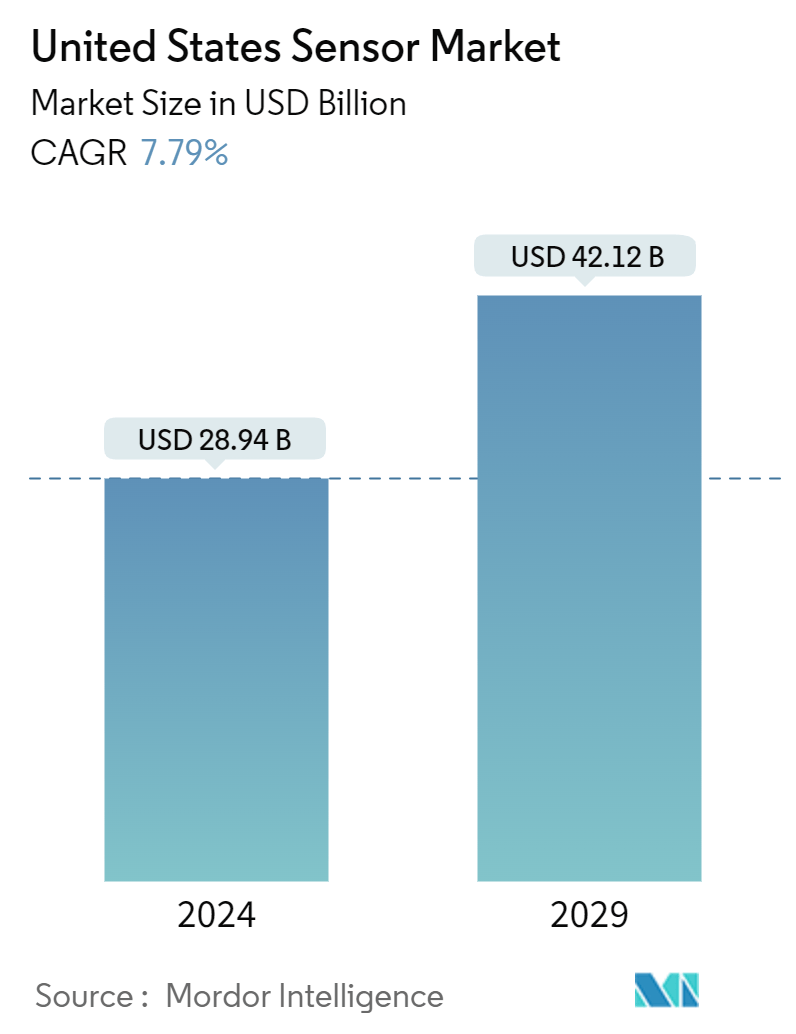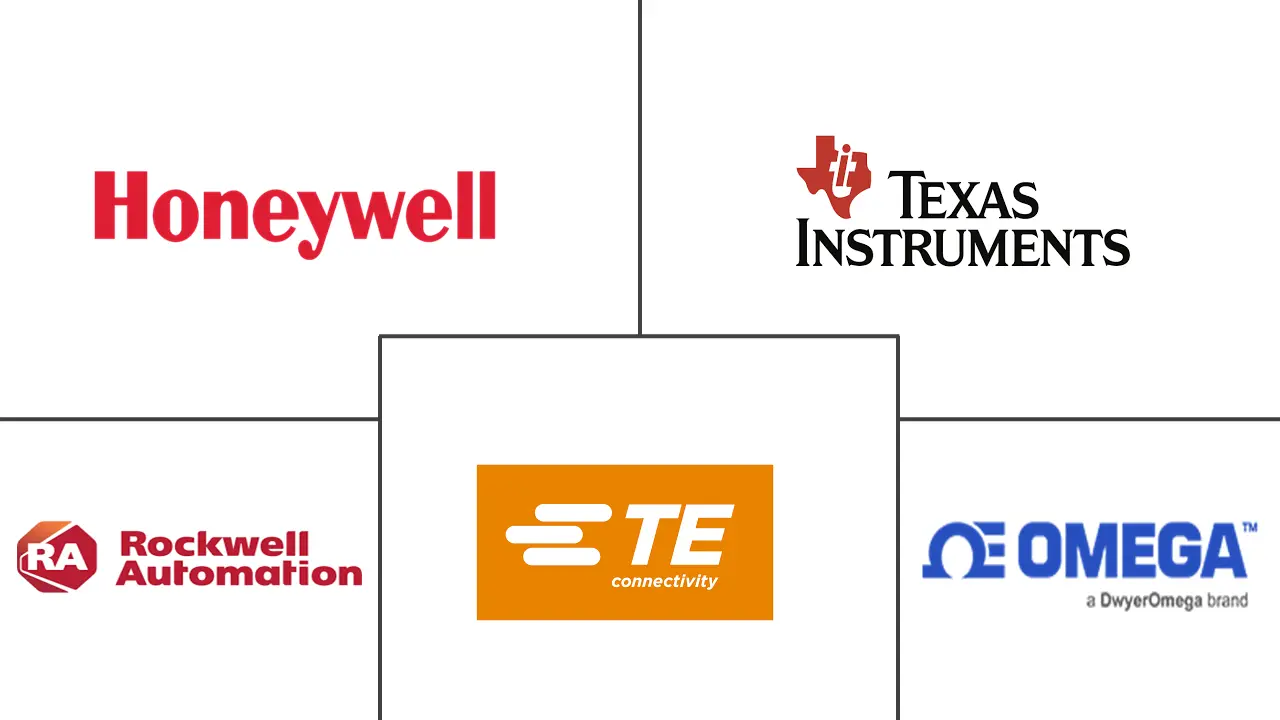Market Size of United States Sensor Industry

| Study Period | 2019 - 2029 |
| Base Year For Estimation | 2023 |
| Market Size (2024) | USD 28.94 Billion |
| Market Size (2029) | USD 42.12 Billion |
| CAGR (2024 - 2029) | 7.79 % |
| Market Concentration | Low |
Major Players
*Disclaimer: Major Players sorted in no particular order |
United States Sensor Market Analysis
The United States Sensor Market size is estimated at USD 28.94 billion in 2024, and is expected to reach USD 42.12 billion by 2029, growing at a CAGR of 7.79% during the forecast period (2024-2029).
A sensor is designed to detect and react to various inputs from the physical environment, such as pressure, heat, light, motion, and moisture. The resulting output typically consists of a signal that can be displayed in a human-readable format at the sensor's location or transmitted electronically over a network for easy reading or additional processing.
• The increasing demand for intelligent sensor technology is evident in various industries, from smartphone navigation systems to driver-assistance systems. Sensors are playing a vital role in staying competitive in the technology sector. Major trends like the Internet of Things (IoT), wearable health monitoring systems, and vehicle automation drive this demand. Consequently, intelligent sensors are now more accessible, enabling businesses in various industries to enhance automation, productivity, efficiency, and safety measures.
• The evolution of sensing technology is apparent with advancements in process automation, leading to the development of more capable and interconnected sensing devices. As the shift toward digitalization speeds up, there is a growing demand for increased process automation, improved anomaly detection, and predictive maintenance capabilities, prompting a significant uptake of sensing technology.
• Due to ongoing technological advancements, the automotive industry in the United States is experiencing a growing need for electronic sensors, especially for position-sensing applications. The industry's focus on technical progress, such as electrification and autonomous driving, has increased the demand for sensors. Additionally, the trend of incorporating position sensors into vehicles demonstrates a promising future for the market’s growth.
• Additionally, the increasing market for smart vehicles and the growing use of sensors by automotive original equipment manufacturers (OEMs) in the United States also drive the demand for sensors in the automotive sector. The rise in demand for sensors in the automotive industry is further bolstered by the enforcement of regulations requiring the use of specific sensors in vehicles.
• While integrating sensors enhances industrial automation, it comes with an added cost that may be a limiting factor in cost-sensitive applications. Furthermore, the high costs associated with research and development for creating new products pose a significant challenge, especially for smaller sensor manufacturers that may lack funds.
United States Sensor Industry Segmentation
The market is defined by the revenue generated from the sales of different types of sensors in different modes of operations offered by different market players for various end-user industries across the United States.
The United States sensor market product type (temperature, pressure, level, flow, proximity, environmental, chemical, inertial, magnetic (hall effect sensors, other magnetic sensors), position sensors, current sensors, other types), mode of operation (optical, electrical resistance, biosensor, piezoresistive, image, capacitive, piezoelectric, lidar, radar, other modes of operation), end-user industry (automotive, consumer electronics, energy, industrial and other, medical and wellness, construction, agriculture and mining, aerospace, robotics). The market sizes and forecasts are provided in terms of value (USD) for all the above segments.
| By Product Type | ||||
| Pressure | ||||
| Level | ||||
| Flow | ||||
| Proximity | ||||
| Environmental | ||||
| Chemical | ||||
| Inertial | ||||
| ||||
| Position Sensors | ||||
| Current Sensors | ||||
| Other Types |
| By Mode of Operation | |
| Optical | |
| Electrical Resistance | |
| Biosensor | |
| Piezoresistive | |
| Image | |
| Capacitive | |
| Piezoelectric | |
| Lidar | |
| Radar | |
| Other Modes of Operation |
| By End-user Industry | |
| Automotive | |
| Consumer Electronics | |
| Energy | |
| Industrial and Other | |
| Medical and Wellness | |
| Construction, Agriculture and Mining | |
| Aerospace | |
| Robotics |
United States Sensor Market Size Summary
The United States sensor market is poised for significant growth, driven by the increasing demand for intelligent sensor technology across various industries. Sensors, which detect and respond to environmental inputs like pressure, heat, and motion, are becoming integral to advancements in the Internet of Things (IoT), wearable health monitoring, and vehicle automation. This demand is further fueled by the automotive industry's focus on electrification and autonomous driving, which necessitates the use of electronic sensors. The market is also witnessing a surge in the adoption of chemical sensors, particularly in healthcare and environmental monitoring, as they provide real-time data and non-invasive monitoring capabilities. The rise of smart vehicles and the enforcement of regulations requiring specific sensors in vehicles are additional factors contributing to market expansion.
In the consumer electronics sector, sensors play a crucial role in enhancing the functionality and user experience of devices such as smartphones, tablets, and smart home appliances. The growing popularity of smart consumer electronics and IoT devices is expected to drive further demand for sensors. Despite the high costs associated with integrating sensors and the challenges in research and development, the market remains competitive, with major players like Texas Instruments and Honeywell International influencing its trajectory. Recent technological advancements, such as STMicroelectronics' 3D LiDAR module and ams OSRAM's CMOS image sensor, highlight the ongoing innovation within the industry. As the market continues to evolve, the increasing presence of prominent manufacturers is anticipated to intensify competitive rivalry, shaping the future landscape of the United States sensor market.
United States Sensor Market Size - Table of Contents
-
1. MARKET INSIGHTS
-
1.1 Market Overview
-
1.2 Industry Attractiveness - Porter's Five Forces Analysis
-
1.2.1 Bargaining Power of Suppliers
-
1.2.2 Bargaining Power of Buyers
-
1.2.3 Threat of New Entrants
-
1.2.4 Threat of Substitutes
-
1.2.5 Degree of Competition
-
-
1.3 Industry Value Chain/Supply Chain Analysis
-
-
2. MARKET SEGMENTATION
-
2.1 By Product Type
-
2.1.1 Pressure
-
2.1.2 Level
-
2.1.3 Flow
-
2.1.4 Proximity
-
2.1.5 Environmental
-
2.1.6 Chemical
-
2.1.7 Inertial
-
2.1.8 Magnetic
-
2.1.8.1 Hall Effect Sensors
-
2.1.8.2 Other Magnetic Sensors
-
-
2.1.9 Position Sensors
-
2.1.10 Current Sensors
-
2.1.11 Other Types
-
-
2.2 By Mode of Operation
-
2.2.1 Optical
-
2.2.2 Electrical Resistance
-
2.2.3 Biosensor
-
2.2.4 Piezoresistive
-
2.2.5 Image
-
2.2.6 Capacitive
-
2.2.7 Piezoelectric
-
2.2.8 Lidar
-
2.2.9 Radar
-
2.2.10 Other Modes of Operation
-
-
2.3 By End-user Industry
-
2.3.1 Automotive
-
2.3.2 Consumer Electronics
-
2.3.3 Energy
-
2.3.4 Industrial and Other
-
2.3.5 Medical and Wellness
-
2.3.6 Construction, Agriculture and Mining
-
2.3.7 Aerospace
-
2.3.8 Robotics
-
-
United States Sensor Market Size FAQs
How big is the United States Sensor Market?
The United States Sensor Market size is expected to reach USD 28.94 billion in 2024 and grow at a CAGR of 7.79% to reach USD 42.12 billion by 2029.
What is the current United States Sensor Market size?
In 2024, the United States Sensor Market size is expected to reach USD 28.94 billion.

